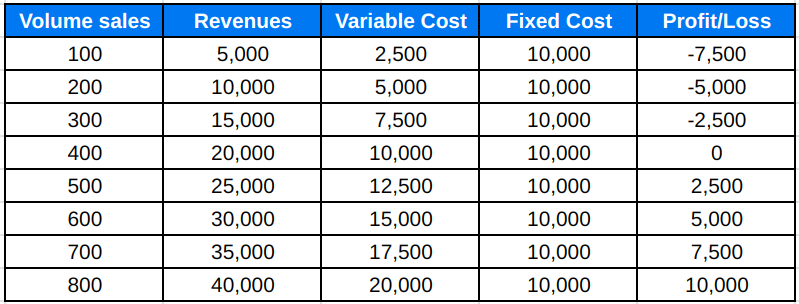
Why Contribution Profit is a Big Deal?
Let’s say you want to put up a lemonade stand at a college fest. The rent for this stand is 10,000. The cost of making a lemonade with lemon, syrup, soda, and ice is 25. You plan to sell it for 50 per glass.
How many lemonades should you sell to make profits or break even? Let’s ignore taxes for now.
If you sell 200 lemonades –
- Your revenue is 200 * 50 = 10,000
- Cost of making 200 lemonades = 25 * 200 = 5000
- Rent = 10,000
- Total cost = Rent + lemonades making charges, i.e., 15,000
- P&L = Revenue – Total cost i.e., 10,000 – 15,000 = -5,000 (loss)
What happens if you sell 500 lemonades instead of 200?
Your cost of making lemonades increases to 12,500 plus a fixed rent of 10,000.
- Total Revenue = 500*50 = 25000
- Total Costs = 22,500
- P&L = 2,500
At 500 lemonades, you make a net profit. In fact, here is a table giving you P&L at various lemonade sales points.
Irrespective of your sales number, in all scenarios, you achieve a contribution profit. That applies even if you sell a single glass of lemonade. How is that?
Contribution profit = Revenue – variable cost.
At your lemonade stand, your variable costs include lemon, syrup, soda, and ice, which amount to 25 per glass. So, if you sell just one glass of lemonade for 50, you will make a contribution profit of 25. You should be able to sell enough lemonades that this contribution profit provides for both fixed costs and net profit. Therefore,
Contribution profit = fixed cost + net profit.
The table above shows that while your variable costs grew in line with revenues, fixed costs (stall rental) remained the same. The more you sell, the more variable costs you need to bear. See the table below. On a per-unit basis, your variable costs remain the same, but your per-unit fixed cost is reduced.

It is for this phenomenon that companies want to grow bigger. They see economies of scale. Their per-unit costs start shrinking as they produce in larger quantities, giving way to net profits. And this does not even account for bulk discounts. As you purchase raw materials in larger quantities, your vendors might be willing to offer you larger discounts. That means your per-unit variable costs could also come down.
The other way is true as well. There is a limit to how many lemonades you can sell out of a stall. You might reach a sales volume for which you might need a bigger space for your business or a bigger stall, as in the case of the lemonade stand example. In such cases, you will have to decide if you want to restrict your business to a size that your existing space can support or if you should expand. Ideally, if you see adequate demand for your product, you might want to invest in a larger space or lemonade stall.
Now, here’s the catch. Our lemonade example was a simplistic one. What if there are other lemonade stands competing with you? They might be selling at 40 or even 30 per glass. What if someone, let’s call him Jay, starts selling lemonades at 20? That is below your variable costs. A small contribution profit at least means you can sell more and achieve net profitability. But how would you cover contribution losses?
For every glass you sell at 20, you will lose 5. And that does not even account for the stall rental. You may not even get into the lemonade business. Wait! Why is Jay selling lemonade for 20? How is it even sustainable?
Let’s explore the possibilities.
- By selling at such low prices, most customers will buy lemonade from Jay. Others might lose business and shut shop. So, Jay is hoping to edge out the competition.
- More customers will buy lemonade from Jay because it is more affordable. Jay’s sales volume will increase. Higher volumes will allow him to make bulk purchases at deep discounts. That way, his variable costs will come down, thereby leading to contribution profits.
- Once the competition is edged out and customers are hooked on his lemonade, Jay can slowly increase prices to make profits.
Each of these possibilities might take years to consummate. All this while, Jay will continue to sell at prices that do not even cover the variable costs. Most startups operate on this mantra. It, therefore, becomes a big event for a startup when it churns out contribution profits.
How will Jay afford losses for years if it takes so long to edge out the competition? He probably has venture capital money. Venture capitalists might have invested large amounts of capital into Jay’s lemonade business. Ideally, it is Jay’s responsibility to earn profits and grow this capital for his investors. But his investors are patient. Jay can make losses and reduce capital in the initial years if he has the confidence and ability to deliver huge profits in the later years. He can do so eventually by selling at higher prices or scaling up to reduce costs.

Vineet Sir please update Sector Analysis Module